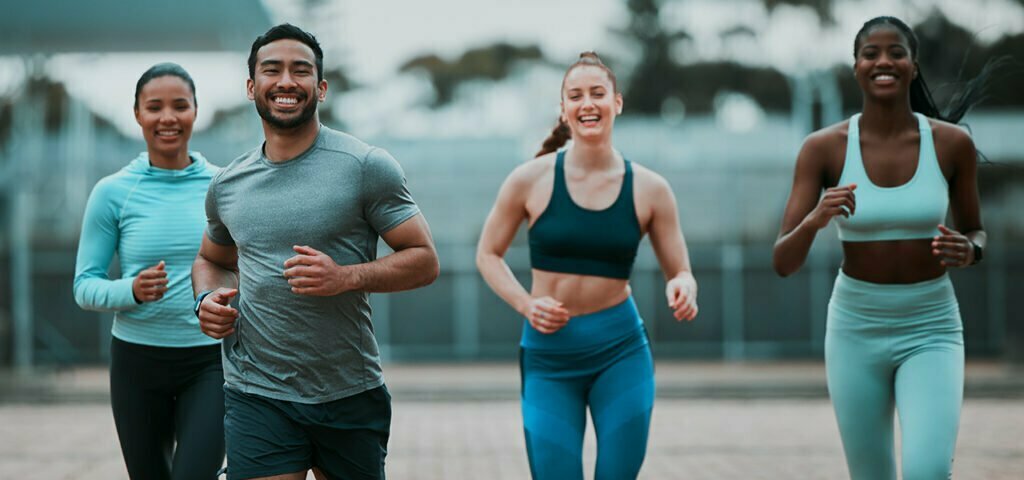Keep Moving With These 9 Fitness Tips


Being active can help you maintain a healthy weight, reduce blood pressure, build strong bones, relieve stress, and maintain flexibility and good posture.
Recreational sport is a great way to enjoy the many benefits of physical activity whether you pick up a hockey stick, golf club, racquet, or paddle, get on a bike, or put on your running shoes! The important thing is to get moving. Canada’s Olympic athletes know that everyone who gets physically active is a winner.
Here are 9 tips from our top performers and Canada’s chiropractors to help you avoid injury and get the most from your favorite sport:
1. Warm Up
Before jumping in the pool, hitting the field, or picking up a golf club, take a full 20 minutes – no less – to warm up. Your warmup should include deep breathing exercises, gentle stretching and range of movement exercises, as well as a brisk walk or easy jog to loosen and warm the muscles and joints.
2. Learn Proper Technique
Learn the right technique for your sport from the beginning. Using the wrong sport-specific technique can create incorrect muscle memory and can make it difficult to break bad habits. Poor technique can also cause injury to your joints and muscles.
3. Use the Right Equipment
Make sure your equipment is the right fit, height, and capacity for you to avoid a sports-related injury. Recreational athletes should have their equipment professionally fitted and checked before starting out.
4. Avoid Over-Training
Too much. Too fast. Too soon. Over-training is one of the most common causes of recreational athletic injuries. Take your time and work up to it slowly before pushing yourself too hard. Remember – rest is as important as training.
5. Strength Training
Strength training will help you keep your spine and other body joints functioning optimally. It will also build muscle that is an important shock absorber and helps to prevent strains and sprains.
6. Muscle & Joint Function
Maintaining good muscle and joint range of motion will contribute to your performance and help prevent injury. Restrictions in muscle and joint functioning can hamper your technique and lead to painful strains and sprains.
7. Cool Down
Cooling down after a workout is just as important as warming up. Take 20 minutes for a brisk walk or slow jog and stretch out your muscles and joints before heading for the change room or the car.
8. Drink Fluids
Drink plenty of fluids before, during and after physical activity – even in cold weather. Remember that once you are thirsty, you are already starting to dehydrate. Dehydration affects your energy level and your physical functioning.
9. Treat Injuries Promptly
If you suffer an injury or experience pain that lasts longer than your usual post-workout soreness, ice the area to reduce swelling and inflammation, and consult a chiropractor.
“Chiropractic care has reduced my recovery time from injuries and lessened my susceptibility to injury. I would recommend a physical assessment and chiropractic maintenance to anyone who is serious about their sport.” -Daniel Igali, Wrestling World Champion and Olympic Gold Medalist
“Taking care of injuries is important, but what is just as important is ‘tuning up’ your body to ensure a great performance every time you go out. I was so impressed with my chiropractic care throughout my rowing career, that I became a chiropractor myself.” -Dr. Derek Porter, Rowing World Champion and Olympic Gold Medalist
“As a full-time athlete, I rely on my body to make a living, so it always has to be at its best. Chiropractic care is an important part of keeping me in the best condition so I can perform at an optimal level.” -Perdita Felicien, Sprint Hurdles World Champion and Olympian
“Bobsleigh is a pure power sport – joints especially take a beating. Knees, back, ankles, elbows are constantly being abused through our weight training and sprinting. By having a regular chiropractic assessment, potential problem areas can be identified and worked on before they lead to greater problems.” -Pierre Lueders, Bobsleigh World Champion and Olympic Gold Medalist
“Chiropractic was an important part of my athletic training. It helped keep my body in line and that allowed me to drive with my legs and pry with my lower back. It also helped facilitate recovery and prevent injury.” -Marnie McBean, Rowing World Champion and Olympic Gold Medalist